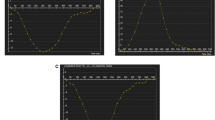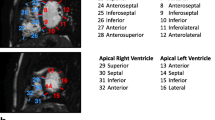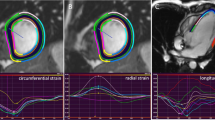Abstract
Objectives
A fast cardiovascular magnetic resonance (CMR) feature tracking was applied to assess ventricular systolic and diastolic function. This study sought to detect right ventricular (RV) systolic and diastolic abnormalities in asymptomatic pediatric repaired tetralogy of Fallot (rTOF) patients with preserved RV ejection fraction (EF).
Methods
One hundred asymptomatic pediatric rTOF patients with preserved RVEF ≥ 45% and 52 control subjects underwent cine CMR examinations. Tricuspid annular plane systolic excursion (TAPSE); peak tricuspid annular systolic (Sm), early diastolic (Em), and late diastolic (Am) velocities; and biventricular global radial (GRS), circumferential (GCS), and longitudinal strains (GLS) were analyzed using CMR feature tracking.
Results
TAPSE, Sm, Em, Am, and RV GLS were significantly lower in rTOF patients compared with controls (all p < 0.01). The lower limits (mean–2·standard deviations) of TAPSE, Sm, Em, and Am among controls were 10.9 mm, 6.3 cm/s, 8.9 cm/s, and 2.4 cm/s, respectively, and 78%, 75%, 75%, and 19% of rTOF patients had corresponding measurements below these thresholds. Among rTOF patients, RV GLS was significantly lower in females than in males (p < 0.05).
Conclusions
Despite preserved RVEF, there was a high prevalence of RV systolic and diastolic dysfunction among pediatric rTOF patients, which was detected using fast CMR feature tracking.
Key Points
• There was high prevalence of systolic and diastolic dysfunction in asymptomatic pediatric repaired tetralogy of Fallot (rTOF) patients despite preserved right ventricular (RV) ejection fraction (EF).
• Significant correlations were observed between right ventricular (RV) measurements (strains, tricuspid annular plane systolic excursion (TAPSE), peak tricuspid annular early diastolic velocity (E m ), peak tricuspid annular late diastolic velocity (A m )), and left ventricular (LV) strain measurements, which indicates ventricular–ventricular interactions at systolic and diastolic function level.
• Right ventricular (RV) global longitudinal strain (GLS) was lower in female repaired tetralogy of Fallot (rTOF) patients than in males, suggesting females with rTOF may be at a higher risk of developing RV systolic dysfunction than males.



Similar content being viewed by others
Abbreviations
- 2CH:
-
Two-chamber
- 2D:
-
Two-dimensional
- 3CH:
-
Three-chamber
- 4CH:
-
Four-chamber
- A m :
-
Peak tricuspid annular late diastolic velocity
- BSA:
-
Body surface area
- CI:
-
Cardiac index
- CMR:
-
Cardiovascular magnetic resonance
- CO:
-
Cardiac output
- EDV:
-
End-diastolic volume
- EF:
-
Ejection fraction
- E m :
-
Peak tricuspid annular early diastolic velocity
- ESV:
-
End-systolic volume
- GCS:
-
Global circumferential strain
- GLS:
-
Global longitudinal strain
- GRS:
-
Global radial strain
- IQR:
-
Interquartile range
- LGE:
-
Late gadolinium enhancement
- LV:
-
Left ventricular
- PR:
-
Pulmonary regurgitation
- rTOF:
-
Repaired tetralogy of Fallot
- RV:
-
Right ventricular
- SA:
-
Short axis
- SD:
-
Standard deviation
- S m :
-
Peak tricuspid annular systolic velocity
- SV:
-
Stroke volume
- TA:
-
Tricuspid annulus
- TAPSE:
-
Tricuspid annular plane systolic excursion
- TOF:
-
Tetralogy of Fallot
References
Apitz C, Webb GD, Redington AN (2009) Tetralogy of Fallot. Lancet 374:1462–1471
Smith CA, McCracken C, Thomas AS et al (2019) Long-term outcomes of tetralogy of Fallot: a study from the pediatric cardiac care consortium. JAMA Cardiol 4:34–41
Villafañe J, Feinstein JA, Jenkins KJ et al (2013) Hot topics in tetralogy of Fallot. J Am Coll Cardiol 62:2155–2166
Therrien J, Marx GR, Gatzoulis MA (2002) Late problems in tetralogy of Fallot—recognition, management, and prevention. Cardiol Clin 20:395–404
Gatzoulis MA, Balaji S, Webber SA et al (2000) Risk factors for arrhythmia and sudden cardiac death late after repair of tetralogy of Fallot: a multicentre study. Lancet 356:975–981
Valente AM, Gauvreau K, Assenza GE et al (2013) Rationale and design of an International Multicenter Registry of patients with repaired tetralogy of Fallot to define risk factors for late adverse outcomes: the INDICATOR cohort. Pediatr Cardiol 34:95–104
Bhagra CJ, Hickey EJ, Van De Bruaene A, Roche SL, Horlick EM, Wald RM (2017) Pulmonary valve procedures late after repair of tetralogy of Fallot: current perspectives and contemporary approaches to management. Can J Cardiol 33:1138–1149
Geva T (2013) Indications for pulmonary valve replacement in repaired tetralogy of Fallot: the quest continues. Circulation 128:1855–1857
Gatzoulis MA, Elliott JT, Guru V et al (2000) Right and left ventricular systolic function late after repair of tetralogy of Fallot. Am J Cardiol 86:1352–1357
Wald RM, Valente AM, Gauvreau K et al (2015) Cardiac magnetic resonance markers of progressive RV dilation and dysfunction after tetralogy of Fallot repair. Heart 101:1724–1730
Bokma JP, de Wilde KC, Vliegen HW et al (2017) Value of cardiovascular magnetic resonance imaging in noninvasive risk stratification in tetralogy of Fallot. JAMA Cardiol 2:678–683
Andrade AC, Jerosch-Herold M, Wegner P et al (2019) Determinants of left ventricular dysfunction and remodeling in patients with corrected tetralogy of Fallot. J Am Heart Assoc 8:e009618
Friedberg MK (2018) Imaging right-left ventricular interactions. J Am Coll Cardiol Img 11:755–771
Gulati A, Ismail TF, Jabbour A (2013) The prevalence and prognostic significance of right ventricular systolic dysfunction in nonischemic dilated cardiomyopathy. Circulation 128:1623–1633
van Everdingen WM, Zweerink A, Nijveldt R et al (2018) Comparison of strain imaging techniques in CRT candidates: CMR tagging, CMR feature tracking and speckle tracking echocardiography. Int J Cardiovasc Imaging 34:443–456
Houard L, Benaets MB, de Meester de Ravenstein C et al (2019) Additional prognostic value of 2D right ventricular speckle-tracking strain for prediction of survival in heart failure and reduced ejection fraction: a comparative study with cardiac magnetic resonance. J Am Coll Cardiol Img 12:2373–2385
Claus P, Omar AMS, Pedrizzetti G et al (2015) Tissue tracking technology for assessing cardiac mechanics. J Am Coll Cardiol Img 8:1444–1460
Heermann P, Fritsch H, Koopmann M et al (2019) Biventricular myocardial strain analysis using cardiac magnetic resonance feature tracking (CMR-FT) in patients with distinct types of right ventricular diseases comparing arrhythmogenic right ventricular cardiomyopathy (ARVC), right ventricular outflow-tract tachycardia (RVOT-VT), and Brugada syndrome (BrS). Clin Res Cardiol 108:1147–1162
Kempny A, Fernández-Jiménez R, Orwat S et al (2012) Quantification of biventricular myocardial function using cardiac magnetic resonance feature tracking, endocardial border delineation and echocardiographic speckle tracking in patients with repaired tetralogy of Fallot and healthy controls. J Cardiovasc Magn Reson 14:32
Grothues F, Moon JC, Bellenger NG, Smith GS, Klein HU, Pennell DJ (2004) Interstudy reproducibility of right ventricular volumes, function, and mass with cardiovascular magnetic resonance. Am Heart J 147:218–223
Leng S, Jiang M, Zhao XD et al (2016) Three-dimensional tricuspid annular motion analysis from cardiac magnetic resonance feature-tracking. Ann Biomed Eng 44:3522–3538
Leng S, Zhao XD, Huang FQ et al (2015) Automated quantitative assessment of cardiovascular magnetic resonance-derived atrioventricular junction velocities. Am J Physiol Heart Circ Physiol 309:H1923–H1935
Leng S, Tan RS, Zhao X, Allen JC, Koh AS, Zhong L (2020) Fast long-axis strain: a simple, automatic approach for assessing left ventricular longitudinal function with cine cardiovascular magnetic resonance. Eur Radiol 30:3672–3683
Leng S, Tan RS, Zhao X, Allen JC, Koh AS, Zhong L (2018) Validation of a rapid semi-automated method to assess left atrial longitudinal phasic strains on cine cardiovascular magnetic resonance imaging. J Cardiovasc Magn Reson 20:71
Leng S, Dong Y, Wu Y et al (2019) Impaired cardiovascular magnetic resonance-derived rapid semiautomated right atrial longitudinal strain is associated with decompensated hemodynamics in pulmonary arterial hypertension. Circ Cardiovasc Imaging 12(5):e008582
Fratz S, Chung T, Greil GF et al (2013) Guidelines and protocols for cardiovascular magnetic resonance in children and adults with congenital heart disease: SCMR expert consensus group on congenital heart disease. J Cardiovasc Magn Reson 15:51
Schulz-Menger J, Bluemke DA, Bremerich J et al (2020) Standardized image interpretation and post-processing in cardiovascular magnetic resonance - 2020 update: Society for Cardiovascular Magnetic Resonance (SCMR): Board of Trustees Task Force on Standardized Post-Processing. J Cardiovasc Magn Reson 22:19
Mercer-Rosa L, Yang W, Kutty S, Rychik J, Fogel M, Goldmuntz E (2012) Quantifying pulmonary regurgitation and right ventricular function in surgically repaired tetralogy of Fallot: a comparative analysis of echocardiography and magnetic resonance imaging. Circ Cardiovasc Imaging 5:637–643
Berganza FM, de Alba CG, Özcelik N, Adebo D (2017) Cardiac magnetic resonance feature tracking biventricular two-dimensional and three-dimensional strains to evaluate ventricular function in children after repaired tetralogy of Fallot as compared with healthy children. Pediatr Cardiol 38:566–574
Schuster A, Stahnke VC, Unterberg-Buchwald C et al (2015) Cardiovascular magnetic resonance feature-tracking assessment of myocardial mechanics: inter-vendor agreement and considerations regarding reproducibility. Clin Radiol 70:989–998
Orwat S, Diller GP, Kempny A et al (2016) Myocardial deformation parameters predict outcome in patients with repaired tetralogy of Fallot. Heart 102:209–215
Kalaitzidis P, Orwat S, Kempny A et al (2018) Biventricular dyssynchrony on cardiac magnetic resonance imaging and its correlation with myocardial deformation, ventricular function and objective exercise capacity in patients with repaired tetralogy of Fallot. Int J Cardiol 264:53–57
Saxena N, Rajagopalan N, Edelman K, López-Candales A (2006) Tricuspid annular systolic velocity: a useful measurement in determining right ventricular systolic function regardless of pulmonary artery pressures. Echocardiography 23:750–755
Egbe AC, Pislaru SV, Kothapalli S et al (2019) The role of echocardiography for quantitative assessment of right ventricular size and function in adults with repaired tetralogy of Fallot. Congenit Heart Dis 14:700–705
Aloia E, Cameli M, D'Ascenzi F, Sciaccaluga C, Mondillo S (2016) TAPSE: an old but useful tool in different diseases. Int J Cardiol 225:177–183
Carlsson M, Ugander M, Heiberg E, Arheden H (2007) The quantitative relationship between longitudinal and radial function in left, right, and total heart pumping in humans. Am J Physiol Heart Circ Physiol 293:H636–H644
Yu CM, Lin H, Yang H, Kong SL, Zhang Q, Lee SW (2002) Progression of systolic abnormalities in patients with “isolated” diastolic heart failure and diastolic dysfunction. Circulation 105:1195–1201
DiLorenzo M, Hwang WT, Goldmuntz E, Ky B, Mercer-Rosa L (2018) Diastolic dysfunction in tetralogy of Fallot: comparison of echocardiography with catheterization. Echocardiography 35:1641–1648
Aboulhosn JA, Lluri G, Gurvitz MZ et al (2013) Left and right ventricular diastolic function in adults with surgically repaired tetralogy of Fallot: a multi-institutional study. Can J Cardiol 29:866–872
Kempny A, Diller GP, Orwat S et al (2012) Right ventricular-left ventricular interaction in adults with tetralogy of Fallot: a combined cardiac magnetic resonance and echocardiographic speckle tracking study. Int J Cardiol 154:259–264
Anderson RH, Ho SY, Redmann K, Sanchez-Quintana D, Lunkenheimer PP (2005) The anatomical arrangement of the myocardial cells making up the ventricular mass. Eur J Cardiothorac Surg 28:517–525
Corno AF, Kocica MJ, Torrent-Guasp F (2006) The helical ventricular myocardial band of Torrent-Guasp: potential implications in congenital heart defects. Eur J Cardiothorac Surg 29(Suppl 1):S61–S68
Ho SY, Nihoyannopoulos P (2006) Anatomy, echocardiography, and normal right ventricular dimensions. Heart 92(Suppl 1):i2–i13
Helbing WA, Roest AA, Niezen RA et al (2002) ECG predictors of ventricular arrhythmias and biventricular size and wall mass in tetralogy of Fallot with pulmonary regurgitation. Heart 88:515–519
Li L, Zhao Q, Kong W (2018) Extracellular matrix remodeling and cardiac fibrosis. Matrix Biol 68-69:490–506
Gyöngyösi M, Winkler J, Ramos I et al (2017) Myocardial fibrosis: biomedical research from bench to bedside. Eur J Heart Fail 19:177–191
Babu-Narayan SV, Kilner PJ, Li W et al (2006) Ventricular fibrosis suggested by cardiovascular magnetic resonance in adults with repaired tetralogy of Fallot and its relationship to adverse markers of clinical outcome. Circulation 113:405–413
Chen CA, Dusenbery SM, Valente AM, Powell AJ, Geva T (2016) Myocardial ECV fraction assessed by CMR is associated with type of hemodynamic load and arrhythmia in repaired tetralogy of Fallot. J Am Coll Cardiol Img 9:1–10
Sarikouch S, Boethig D, Peters B et al (2013) Poorer right ventricular systolic function and exercise capacity in women after repair of tetralogy of Fallot: a sex comparison of standard deviation scores based on sex-specific reference values in healthy control subjects. Circ Cardiovasc Imaging 6:924–933
Yim D, Riesenkampff E, Caro-Dominguez P, Yoo SJ, Seed M, Grosse-Wortmann L (2017) Assessment of diffuse ventricular myocardial fibrosis using native T1 in children with repaired tetralogy of Fallot. Circ Cardiovasc Imaging 10:e00569
Sarikouch S, Koerperich H, Dubowy KO et al (2011) Impact of gender and age on cardiovascular function late after repair of tetralogy of Fallot: percentiles based on cardiac magnetic resonance. Circ Cardiovasc Imaging 4:703–711
Hagdorn QAJ, Beurskens NEG, Gorter TM et al (2020) Sex differences in patients with repaired tetralogy of Fallot support a tailored approach for males and females: a cardiac magnetic resonance study. Int J Cardiovasc Imaging 36:1997–2005
Leonardi B, Drago F, Caldarone CA et al (2020) Impact of age and sex on cardiovascular magnetic resonance measurements: after tetralogy of Fallot repair. J Am Coll Cardiol Img 13:1844–1847
Dobrovie M, Barreiro-Pérez M, Curione D et al (2019) Inter-vendor reproducibility and accuracy of segmental left ventricular strain measurements using CMR feature tracking. Eur Radiol 29:6846–6857
Acknowledgments
The authors would like to thank Xiaofen Yao and Lijun Chen who helped with the data collection.
Funding
This study has received funding from the National Key Research and Development Program of China (No. 2018YFB1107100), the Shanghai Committee of Science and Technology (No. 17411965400), the Key Projects of Shanghai Science and Technology Commission (No. 17411953300), the Shanghai Municipal Commission of Health and Family Planning (No. 201740095), and the Singapore National Medical Research Council (NMRC/OFIRG/0018/2016, MOH-000351).
Author information
Authors and Affiliations
Corresponding authors
Ethics declarations
Guarantor
The scientific guarantor of this publication is Yumin Zhong.
Conflict of interest
The authors of this manuscript declare no relationships with any companies whose products or services may be related to the subject matter of the article.
Statistics and biometry
No complex statistical methods were necessary for this paper.
Informed consent
Informed consent was obtained from all subjects’ guardians.
Ethical approval
Institutional Review Board approval was obtained.
Methodology
• prospective
• diagnostic study
• performed at one institution
Additional information
Publisher’s note
Springer Nature remains neutral with regard to jurisdictional claims in published maps and institutional affiliations.
Supplementary Information
ESM 1
(DOCX 67 kb)
Rights and permissions
About this article
Cite this article
Ouyang, R., Leng, S., Sun, A. et al. Detection of persistent systolic and diastolic abnormalities in asymptomatic pediatric repaired tetralogy of Fallot patients with preserved ejection fraction: a CMR feature tracking study. Eur Radiol 31, 6156–6168 (2021). https://doi.org/10.1007/s00330-020-07643-6
Received:
Revised:
Accepted:
Published:
Issue Date:
DOI: https://doi.org/10.1007/s00330-020-07643-6




